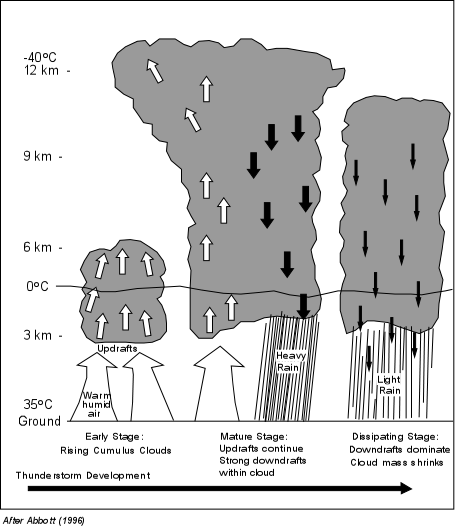
| EENS 3050 | Natural Disasters |
| Tulane University | Prof. Stephen A. Nelson |
Exceptional Weather - Thunderstorms, Tornadoes, Nor'easters, & Drought |
|
|
Thunderstorms
Thunderstorms occur anywhere that warm moist air has absorbed enough heat to make the air less dense than the surrounding air. This commonly occurs along cold fronts, but can occur in other places as well, particularly where daytime heating forms hot air near the Earth's surface. As the warm moist air rises it begins to cool and water begins to condense into tiny droplets that form clouds. Condensation of the water droplets in the clouds releases the latent heat of evaporation, adding heat to the rising air, thus decreasing its density and allowing it to rise to higher levels in the atmosphere. This rising air, called an updraft, starts to build clouds to heights of up to 6 km. |
 |
Further rising and cooling within the clouds causes more condensation, as
well as the formation of ice crystals which release further latent heat and
build cloud heights up to 12 km. Eventually the water droplets and ice
crystals in the clouds become so large that they can no longer be supported
by the uprising air mass, and they begin to fall forming rapid downdrafts on
the leading edge of the cloud. In the mature stage of thunderstorm
development updrafts and downdrafts operate side by side within the cloud.
This is the most dangerous stage of a thunderstorm because of the high winds
accompanying the downdrafts, the heavy rain, as well as thunder, lightning,
and possible hail and tornado development. Eventually the cloud reaches the dissipating stage as
the downdrafts drag in so much cool dry air that it prevents further updrafts of warm
moist air. With lack of updrafts of warm moist air, the cloud begins to dissipate and
eventually it stops raining. Thunderstorms can form as single cells, with only one cloud mass, or as
multiple cells, with several clouds moving along a similar path. |
Although thunderstorms
can occur nearly everywhere, they show an unequal distribution through the United
States. Areas that receive the highest number of thunderstorms are areas where
warm moist air moves northward from the Gulf of Mexico. As seen in the figure to the
right, areas in southwestern Florida have over 100 days per year with a thunderstorm.
|
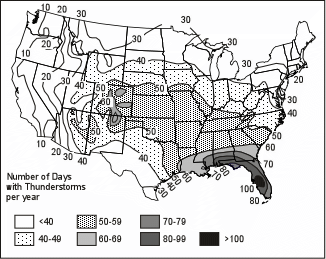 |
Hail - Hail is a rain of semi-spherical, concentrically layered ice
balls that are dropped from some thunderstorms. Hail rarely kills people, but it
does heavy damage to agriculture, roofs, and automobiles. The conditions necessary
to form hail during a thunderstorm are:
Although thunderstorms are most common along the Gulf coast, thunderstorms that produce
hail are more common in the mid-continent region where temperature contrasts between upper
air masses and the rising hot air are greater. Hail can range from pea-size stones
to grapefruit size stones. |
Lightning - Lightning is the electrical discharge from clouds that
causes thunder. Thus, lightning occurs from all thunderstorms. Lightning is
the major cause of forest fires and results in many deaths. |
|
||||||||||||||||||||||
Between 1954 and 2013, an average of 51 deaths per year in the U.S. 131 died in 1969 (deadliest year) 90% of lightning strike victims survive. Deaths from lightning have a similar distribution to the occurrence of thunderstorms, with Florida having both the most thunderstorms and the most lightning deaths. Deaths from lightning usually occur outdoors as seen in the table here. |
|
||||||||||||||||||||||
Lightning is caused by an imbalance of electrical charge between and within clouds and the ground. Most of you have simulated lightning by walking across a carpet on a dry day and then touching a metal object like a door knob. Static electrical charge builds on your body and is discharged to the door knob as a bolt of electricity. |
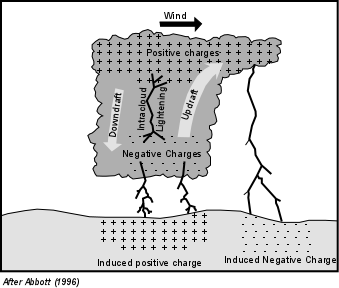 |
During the buildup of a thundercloud, charged particles of water droplets and ice become separated in the cloud. Positively charged particles are moved to the top of the cloud and negatively charged particles are moved to the bottom of the cloud. The thundercloud then begins to interact with the ground. The negatively charged part of the cloud induces a build-up of positive charges on the ground. Similarly beneath the upper positively charged part of the cloud negative charges are induced in the ground below. When the difference in voltage between the oppositely charged parts of the cloud and the ground become great enough, the electricity is discharged as a bolt of lightning.
Note that lightning can travel from the cloud to the ground, from the ground to the cloud, and within the cloud itself. lightning travels at speeds of about 100,000 miles per hour, and usually includes several strokes that all occur within about 1/2 of a second. The discharge of electricity during a bolt of lightning heats up the air surrounding the bolt causing rapid expansion of the air. It is this rapid expansion of the air that causes the sound we call thunder. |
|
Tornadoes
|
|
Tornadoes are funnel shaped clouds that are associated with thunderstorms. Tornadoes have wind velocities higher than hurricanes (up to 500 km/hr [318 miles per hour]), but affect a much smaller area than hurricanes. Over 70% of the tornadoes that occur on Earth occur in the great plains of the United States. Between 1920 and 2004 tornadoes caused 11,560 deaths in the United States, an average of 136 deaths per year. Tornado awareness has reduced the death toll over the last 40 years.
|
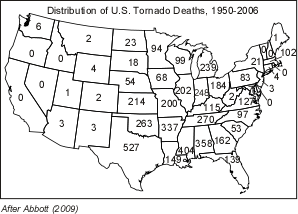 |
| Tornado Development - A tornado develops within a severe thunderstorm
when there is an excessive amount of vertical wind shear. Vertical wind shear is when upper level winds are blowing at a high velocity relative to
lower level winds. Prior to the development of the thunderstorm strong high level
winds blowing from the west initiates a spinning flow near the Earth's surface. This
spinning flow takes the form of an invisible horizontally oriented cylinder. As the
thunderstorm develops, strong updrafts of warm air lifts this rotating air into a more
vertical position within the thundercloud, causing part of the thundercloud to rotate
around the a vortex in a counterclockwise direction. Tornadoes form within this
rotating air, usually at the rear flank of the thunderstorm, and extend down from the
thundercloud occasionally reaching the surface. They travel at velocities between
stationary and 110 km/hr, with cyclonic wind speeds up to 500 km/hr as noted above.
The diameters of tornadoes range from a few tens of meters up to 1.5 km. They do not
often remain in contact with the ground for long periods of time, but can skip across the
surface as the thunderstorm moves along.
|
|
Tornado Intensity - The intensity of a tornado is classified by
the Fujita tornado intensity scale shown in the table below. This was recently (2007) modified and is now called then Enhanced Fujita Scale. Since actually wind velocities during a tornado can only rarely be measured, both scales rely on post-tornado inspections to determine the damage done to various types of structures. This damage is then compared with damage done to similar structures in experiments. The wind velocity and the Fujita Scale rating of the tornado are then based on the comparison. The Enhanced Fujita scale was developed to more accurately reflect the correlation between wind speed and damage based on data collected over the years since the development of the original Fujita Scale. Note that wind velocities are generally lower for the Enhanced Fujita Scale. |
| Fujita Scale | Enhanced Fujita Scale | Potential Damage |
||
| 3 Sec. Wind Gust Speed mph | 3 Sec. Wind Gust Speed mph |
|||
| F0 | 40-79 | EF0 | 65-85 |
Minor damage.
Peels surface off some roofs; some damage to gutters or siding; branches broken off trees; shallow-rooted trees pushed over.
Confirmed tornadoes with no reported damage (i.e., those that remain in open fields) are always rated EF0. |
| F1 | 79-117 | EF1 | 86-110 |
Moderate damage. Roofs severely stripped; mobile homes overturned or badly damaged; loss of exterior doors; windows and other glass broken. |
| F2 | 118-161 | EF2 | 110-135 |
Considerable damage. Roofs torn off well-constructed houses; foundations of frame homes shifted; mobile homes completely destroyed; large trees snapped or uprooted; light-object missiles generated; cars lifted off ground. |
| F3 | 162-209 | EF3 | 136-165 |
Severe damage. Entire stories of well-constructed houses destroyed; severe damage to large buildings such as shopping malls; trains overturned; trees debarked; heavy cars lifted off the ground and thrown; structures with weak foundations blown away some distance. |
| F4 | 210-261 | EF4 | 166-200 |
Extreme damage.Well-constructed houses and whole frame houses completely leveled; cars thrown and small missiles generated. |
| F5 | 262-317 | EF5 | >200 |
Massive Damage. Strong frame houses leveled off foundations and swept away; steel-reinforced concrete structures critically damaged; high-rise buildings have severe structural deformation. Incredible phenomena will occur. |
Tornado Frequency - Tornadoes have occurred in every state of the U.S. except Alaska. Because they are associated with strong thunderstorms, the frequency of tornadoes is closely related to the areas that have lots of thunderstorms, but also occur predominantly in the plains states where cold air descending from above the Rocky Mountains encounters warm air moving northward from the Gulf of Mexico.
|
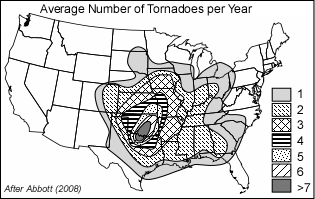 |
|
||||||||||||||||
Since 1985, over 41% of deaths due to tornadoes in the U.S. have involved mobile homes. People in vehicles are much less likely to die. |
|||||||||||||||||
Tornadoes are most common during the spring and summer months. They often occur as swarms associated with cold fronts that move across the U.S. from west to east. One such swarm occurred between April 3rd and 4th, 1974. In 16 hours over 147 tornadoes touched down between Mississippi and Pennsylvania, including six tornadoes of F-5 intensity. This swarm killed 307 people, injured over 6,000, and caused property damage of about $600 million. Note the generally northeast trending tracks of the tornadoes, which is typical of most tornadoes in the U.S.
2011 was a deadly year for tornadoes in the U.S. As of August 24, 1718 tornadoes had been reported in the U.S.,with 1239 confirmed. Worldwide, 566 people died, with 550 in the U.S. The deadliest and most destructive were the April 27 outbreak in the southeastern U.S. and the Joplin, Missouri EF 5 tornado on May 22.
|
| Tornado Damage - Tornado damage is caused by the high wind speed and
high difference in atmospheric pressure between the tornado and its surroundings.
The rotating winds can knock down weaker structures, and the extremely low pressure inside
the tornado generates strong pressure differences between the inside and outside of
buildings. This pressure difference causes roofs to be lifted and removed. The
high winds pick up smaller objects including small structures, animals, people, cars, and
especially mobile homes, and can carry these objects up to several kilometers. The
debris picked up by the winds become rapidly moving projectiles that can become lethal
when hurled against a human body. Tornado Prediction and Warning - Tornadoes cannot be predicted with precision. However, when strong thunderstorm activity is detected, a tornado watch is generally issued for all areas that may fall in the path of the thunderstorm. Doppler radar can detect rotating motion within a thunderstorm and when this is detected, or a tornado is actually observed, a tornado warning is issued for all areas that may fall in the path of the thunderstorm. |
Tornado Safety (from the Federal Emergency Management Agency, FEMA)
|
| Mitigation of Tornado Disasters
Because tornadoes can strike anywhere and anytime there are thunderstorms, the best mitigation is for an educated populace to be aware of the conditions under which tornadoes develop and heed any tornado watches or warnings that are issued by a responsible agency, and practice the tornado safety tips listed above. The only other mitigation that can reduce the damage produced by tornadoes is building codes that require structures to be constructed with extra reinforcing of wood frames and masonry.
|
Other Severe Weather Phenomena Nor'easters |
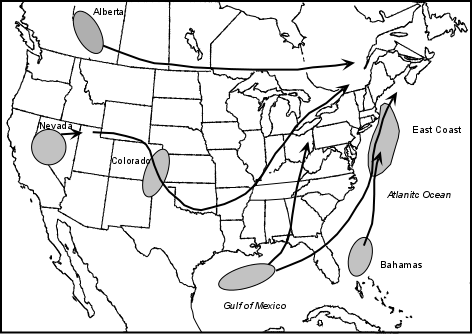 After Coch (1995) |
| Nor'easters originate in various locations and move across the U.S., converging near the east coast. They are called Nor'easters because the cyclonic circulation causes winds to blow out of the northeast as the storms move up coast. Nor'easters usually have winds less than hurricane strength (<115 km/hr), but they last several days and can create storm surges up to 7 meters high. |
| Drought and Famine In contrast to the exceptional weather conditions we have discussed so far, which tend to bring high quantities of rainfall, a drought is a period of time of abnormal dryness in a region. Droughts are slow onset hazards that may lead to secondary effects like famine. |
| In the U.S., droughts are caused when upper level air flow creates a long lasting high pressure ridge over the central U.S. The high pressure causes anticyclonic flow bringing dry air down to the surface. As this air sinks in the high pressure areas it warms and the relative humidity decreases further. Thus the air is so undersaturated with water that it sucks up even more water from the surface. Such persistent high pressure zones block the flow of warm moist air from the Gulf of Mexico, preventing storms that would normally bring rain. Such a condition existed in the central U.S. beginning in 1930, persisting to about 1936. This caused severe dust storms throughout the Midwest, giving the period its name - the great "Dust Bowl". The drought caused massive crop failure, malnutrition, the abandonment of thousands of farms, and large mass-migration of people to California. |
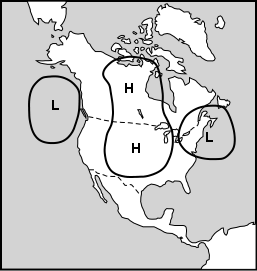 |
Examples of questions on this material that could be asked on an exam
|